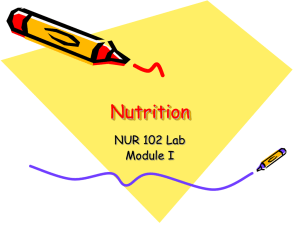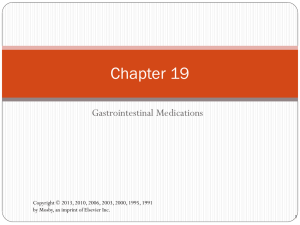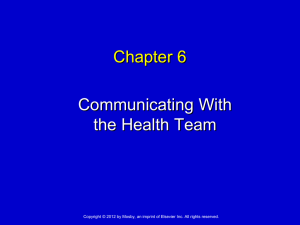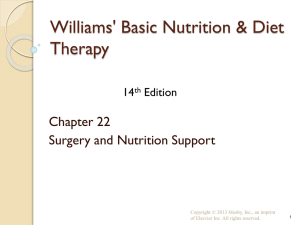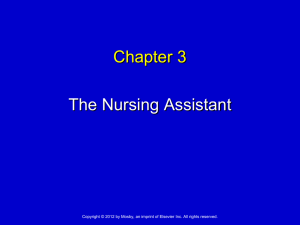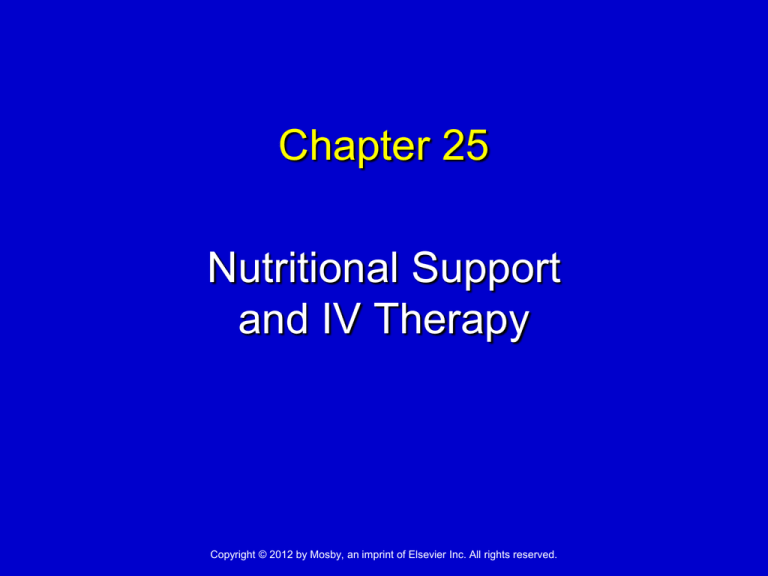
Chapter 25
Nutritional Support
and IV Therapy
Copyright © 2012 by Mosby, an imprint of Elsevier Inc. All rights reserved.
Doctor’s Order
The doctor may order nutritional support or
IV therapy to meet food and fluid needs for
persons who:
Cannot eat or drink because of illness, surgery,
or injury
Have problems eating or refuse to eat or drink
Cannot eat enough to meet their nutritional
needs
Copyright © 2012 by Mosby, an imprint of Elsevier Inc. All rights reserved.
Slide 2
Enteral Nutrition
Enteral nutrition is giving nutrients into the
gastro-intestinal (GI) tract through a feeding
tube.
Gavage is the process of giving a tube feeding.
Tube feedings replace or supplement normal
nutrition.
Copyright © 2012 by Mosby, an imprint of Elsevier Inc. All rights reserved.
Slide 3
Enteral Nutrition (cont’d)
Common feeding tubes
Naso-gastric (NG) tube—Feeding tube is inserted through
the nose into the stomach.
Naso-enteral tube—Feeding tube is inserted through the
nose into the small bowel.
Gastrostomy tube (stomach tube)—Doctor surgically
creates an opening in the stomach and a tube is inserted.
Jejunostomy tube—Feeding tube is inserted into a
surgically created opening in the jejunum of the small
intestine.
Percutaneous endoscopic gastrostomy (PEG) tube—
Doctor inserts the feeding tube with an endoscope.
Copyright © 2012 by Mosby, an imprint of Elsevier Inc. All rights reserved.
Slide 4
Enteral Nutrition (cont’d)
Formulas
The doctor orders the type of formula, the
amount to give, and when to give tube feedings.
Formula is given at room temperature.
Feeding times
Scheduled feedings (intermittent feedings) are
given at certain times.
• At least 4 feedings are given each day.
• The nurse uses a syringe or a feeding bag.
Continuous feedings are given over 24 hours.
• A feeding pump is used.
Copyright © 2012 by Mosby, an imprint of Elsevier Inc. All rights reserved.
Slide 10
Enteral Nutrition (cont’d)
Report the following observations at once:
Nausea
Discomfort during the feeding
Vomiting
Distended (enlarged and swollen) abdomen
Coughing
Complaints of indigestion or heartburn
Redness, swelling, drainage, odor, or pain at the ostomy
site
Fever
Signs and symptoms of respiratory distress
Increased pulse rate
Complaints of flatulence
Diarrhea
Copyright © 2012 by Mosby, an imprint of Elsevier Inc. All rights reserved.
Slide 12
Enteral Nutrition (cont’d)
Aspiration is a major risk from tube feedings.
Aspiration can occur:
• During insertion
• From tube movement out of place
• From regurgitation
To help prevent regurgitation and aspiration:
• Position the person in Fowler’s or semi-Fowler’s
position before the feeding.
•
Maintain Fowler’s or semi-Fowler’s position after the
feeding.
•
Follow the care plan and the nurse’s directions.
Follow the care plan and the nurse’s directions.
Avoid the left side-lying position.
Copyright © 2012 by Mosby, an imprint of Elsevier Inc. All rights reserved.
Slide 13
Enteral Nutrition (cont’d)
Persons with feeding tubes usually are not
allowed to eat or drink.
Feeding tubes can:
Dry mouth, dry lips, and sore throat can cause discomfort.
Irritate and cause pressure on the nose
Change the shape of the nostrils
Cause pressure ulcers
Assisting the nurse with tube feedings
In some states and agencies, nursing assistants give tube
feedings and remove NG tubes.
You are never responsible for inserting feeding tubes or
checking their placement.
Copyright © 2012 by Mosby, an imprint of Elsevier Inc. All rights reserved.
Slide 14
Comfort Measures
Common comfort measures every 2 hours
while the person is awake include oral hygiene,
lubricant for the lips, and mouth rinses.
Measures for nose irritation include cleaning
the nose and nostrils every 4 to 8 hours, and
securing the tube to the nose and to the person’s
garment at the shoulder area to prevent pulling
or dangling.
• Tube feeding can only hang for 8 hours
Parenteral Nutrition
Parenteral nutrition is giving nutrients through
a catheter inserted into a vein.
Often called total parenteral nutrition (TPN) or
hyperalimentation
Nutrient solution is given directly into the
bloodstream; nutrients do not enter the GI tract.
This method is used when:
The person cannot receive oral or enteral
feedings. ie gastric paresis
Oral or enteral feedings are not enough to meet
the person’s needs.
Copyright © 2012 by Mosby, an imprint of Elsevier Inc. All rights reserved.
Slide 17
Total Parenteral Nutrition
Copyright © 2012 by Mosby, an imprint of Elsevier Inc. All rights reserved.
Slide 18
Parenteral Nutrition (cont’d)
Report the following to the nurse at once:
Fever, chills, and other signs and symptoms of infection
Signs and symptoms of sugar imbalances
Chest pain
Difficulty breathing or shortness of breath
Cough
Nausea and vomiting
Diarrhea
Thirst
Rapid heart rate or an irregular heartbeat
Weakness or fatigue
Sweating
Pallor (pale skin)
Trembling
Confusion or behavior changes
Copyright © 2012 by Mosby, an imprint of Elsevier Inc. All rights reserved.
Slide 19
Parenteral Nutrition (cont’d)
Assisting with TPN
The nurse is responsible for all aspects of TPN.
You assist the nurse by carefully observing the
person:
Protecting the IV when ambulating, following Bloodborne
Pathogen Standard and reporting any site issues to the nurse.
You assist with the person’s basic needs and
activities of daily living.
Copyright © 2012 by Mosby, an imprint of Elsevier Inc. All rights reserved.
Slide 20
IV Therapy
Intravenous (IV) therapy (IV infusion) is giving fluids
through a needle or catheter inserted into a vein.
Doctors order IV therapy to:
Provide fluids when they cannot be taken by mouth.
Replace minerals and vitamins lost because of illness
or injury.
Provide sugar for energy.
Give drugs and blood.
RNs are responsible for IV therapy.
State laws vary about your role and that of
LPNs/LVNs in IV therapy.
Copyright © 2012 by Mosby, an imprint of Elsevier Inc. All rights reserved.
Slide 21
IV Therapy (cont’d)
Peripheral and central venous sites are used.
Peripheral IV sites are away from the center of the
body.
Central IV sites are close to the heart.
• The subclavian vein and the internal jugular vein are
•
central venous sites.
The cephalic and basilic veins in the arm also are used.
Catheters inserted into these sites are called peripherally
inserted central catheters (PICCs).
Central venous sites are used:
• For parenteral nutrition
• To give large amounts of fluid
• For long-term IV therapy
• To give drugs that irritate peripheral veins
Copyright © 2012 by Mosby, an imprint of Elsevier Inc. All rights reserved.
Slide 22
IV Therapy (cont’d)
Basic equipment used in IV therapy
The solution container is a plastic bag.
• It is called the IV bag.
A catheter or needle is inserted into a vein.
The IV tube or infusion tubing connects the IV
bag to the catheter or needle. Fluid drips from the
bag into the drip chamber. The clamp is used to
regulate the flow rate.
The IV bag hangs from an IV pole (IV standard)
or ceiling hook.
Copyright © 2012 by Mosby, an imprint of Elsevier Inc. All rights reserved.
Slide 25
IV Therapy (cont’d)
Flow rate
The doctor orders the amount of:
• Fluid to give (infuse)
• Time to give it in
The RN figures the flow rate.
• The flow rate is the number of drops per minute (gtt/min)
or milliliters per hour (mL/hr).
The RN sets the clamp for the flow rate or an
electronic pump may be used to control the flow
rate.
• An alarm sounds if something is wrong.
• Tell the nurse at once if you hear an alarm.
Copyright © 2012 by Mosby, an imprint of Elsevier Inc. All rights reserved.
Slide 26
IV Therapy (cont’d)
Never change the position of the clamp or adjust
any controls on IV pumps.
You can check the flow rate if a pump is not used.
• Count number of drops in 1 minute.
Tell the RN at once if:
• No fluid is dripping.
• The rate is too fast.
• The rate is too slow.
The MD orders specify how much fluid to give over
a certain time period
Copyright © 2012 by Mosby, an imprint of Elsevier Inc. All rights reserved.
Slide 27
IV Therapy (cont’d)
Your state and agency may allow you to:
• Change dressings at peripheral IV sites.
• Discontinue a peripheral IV.
You are never responsible for:
• Starting or maintaining IV therapy
• Regulating the flow rate
• Changing IV bags
• Giving blood or IV drugs
Copyright © 2012 by Mosby, an imprint of Elsevier Inc. All rights reserved.
Slide 28

